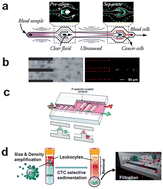Recent advances in microfluidic cell separations
Abstract
The isolation and sorting of cells has become an increasingly important step in chemical and biological analyses. As a unit operation in more complex analyses, isolating a phenotypically pure cell population from a heterogeneous sample presents unique challenges. Microfluidic systems are ideal platforms for performing cell separations, enabling integration with other techniques and enhancing traditional separation modalities. In recent years there have been several techniques that use surface


 Please wait while we load your content...
Please wait while we load your content...